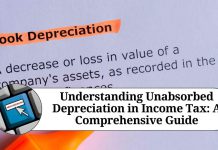Section 115AC of the Income Tax Act was introduced in the year 2016 and has since then been an important aspect of taxation for Non-Resident Indians (NRIs). It relates to the taxation of income earned from the transfer of a specified asset in case of a Non-Resident Indian (NRI).
What is Section 115AC of the Income Tax Act?
Section 115AC of the Income Tax Act deals with the taxation of income earned from the transfer of a specified asset by an NRI. A specified asset includes securities, shares, and other assets in a company, unit of an equity-oriented fund, or a unit of business trust.
The section states that if an NRI sells a specified asset, the tax liability will be calculated at 10% of the capital gains earned. However, the tax will only be levied if the asset was held for a period of more than 24 months. If the asset was held for a period of 24 months or less, the short-term capital gains tax rate will be applicable, which is 15% for equity-oriented funds and 30% for other specified assets.
Who is eligible for Section 115AC?
Section 115AC is applicable to NRIs who have earned capital gains from the transfer of a specified asset. However, there are certain conditions that must be met for an NRI to be eligible for this section. These conditions are:
- The NRI must have earned capital gains from the transfer of a specified asset.
- The NRI must be a resident of a country with which India has signed a Double Taxation Avoidance Agreement (DTAA).
- The NRI must furnish a Tax Residency Certificate (TRC) issued by the tax authorities of their country of residence.
- The NRI must also provide other documents such as a declaration stating that they have not been a resident of India in nine out of the ten preceding years.
Benefits of Section 115AC
Section 115AC provides various benefits to NRIs who earn capital gains from the transfer of a specified asset. The main benefits of this section are:
- Lower tax rate: The tax rate under Section 115AC is only 10%, which is lower than the tax rate applicable to short-term capital gains tax.
- Double Taxation Avoidance Agreement: NRIs who are residents of countries with which India has signed a DTAA can take advantage of the benefits provided under the agreement to avoid double taxation.
- Tax Residency Certificate: The TRC provides evidence of the NRI’s residency in a foreign country, which is important in determining their tax liability.
Conclusion
Section 115AC of the Income Tax Act is an important provision that provides tax benefits to NRIs who earn capital gains from the transfer of a specified asset. NRIs who meet the conditions of this section can take advantage of the lower tax rate and other benefits provided under the section. It is advisable for NRIs to consult a tax expert to understand the tax implications of their investments and to take advantage of the benefits provided under the Income Tax Act.
Read more useful content:
- section 234e of income tax act
- section 286 of income tax act
- section 90a of income tax act
- section 40a(7) of income tax act
- section 226(3) of income tax act
- section 24 of income tax act
Frequently Asked Questions (FAQs)
Q: What is Section 115AC of the Income Tax Act?
A: Section 115AC of the Income Tax Act deals with the taxation of income earned from the transfer of a specified asset by an NRI. A specified asset includes securities, shares, and other assets in a company, unit of an equity-oriented fund, or a unit of business trust.
Q: What is a specified asset?
A: A specified asset includes securities, shares, and other assets in a company, unit of an equity-oriented fund, or a unit of business trust.
Q: Who is eligible for Section 115AC?
A: NRIs who have earned capital gains from the transfer of a specified asset, are residents of a country with which India has signed a Double Taxation Avoidance Agreement (DTAA), furnish a Tax Residency Certificate (TRC) issued by the tax authorities of their country of residence, and have not been a resident of India in nine out of the ten preceding years are eligible for Section 115AC.
Q: What is the tax rate under Section 115AC?
A: The tax rate under Section 115AC is 10% of the capital gains earned from the transfer of a specified asset.
Q: What is the tax rate for short-term capital gains under Section 115AC?
A: The tax rate for short-term capital gains under Section 115AC is 15% for equity-oriented funds and 30% for other specified assets.
Q: What is a Double Taxation Avoidance Agreement (DTAA)?
A: A DTAA is an agreement signed between two countries to avoid double taxation of income. It ensures that income is not taxed twice – once in the country where it is earned and again in the country of residence.
Q: What is a Tax Residency Certificate (TRC)?
A: A TRC is a certificate issued by the tax authorities of a foreign country that certifies the residency of an NRI in that country for the purposes of taxation.
Q: Is Section 115AC applicable to Indian residents?
A: No, Section 115AC is only applicable to NRIs who meet the eligibility criteria mentioned above.
Q: Can an NRI claim credit for taxes paid in India under DTAA?
A: Yes, NRIs can claim credit for taxes paid in India under the DTAA. This means that they can reduce their tax liability in their country of residence by the amount of tax paid in India.
Q: Is Section 115AC applicable to long-term capital gains only?
A: Yes, Section 115AC is applicable to long-term capital gains only. If the specified asset is held for a period of 24 months or less, the short-term capital gains tax rate will be applicable, which is 15% for equity-oriented funds and 30% for other specified assets.
These are some of the frequently asked questions on Section 115AC of the Income Tax Act. It is advisable for NRIs to consult a tax expert to understand the tax implications of their investments and to take advantage of the benefits provided under the Income Tax Act.

































